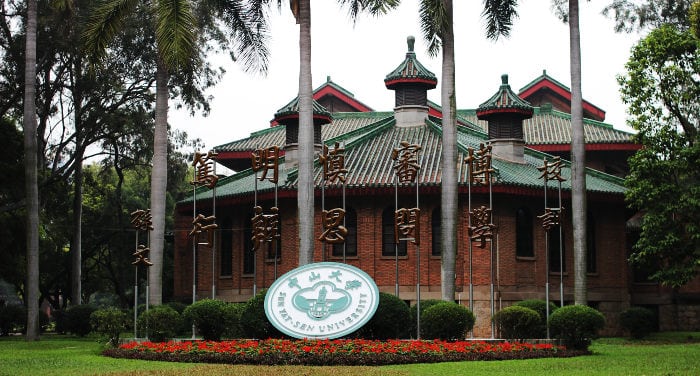
Guangdong is the region that best represents Chinese history in recent centuries: it took on the role of a protagonist during the arrival of Europeans in China, it was the base in 1911 where the revolutionary party of Sun Yatsen saw the disintegration of the longest empire in history, was the headquarters of both the nationalist and communist parties; and it was actually the economic powerhouse of the region that launched the conditions for the Chinese economic miracle and for the exponential growth of the country.
Among the first five special economic zones (FTZ) it was founded along the coast of Guangdong, and the trip to the region from then president Deng Xiaoping held in 1992 definitively ushered in the beginning of a new epoch for the People’s Republic of China.
Why go to Guangdong
The region’s tropical climate makes almost every time of year a good time to visit, and going to Guangdong will allow you to taste the slow rhythms of the inhabitants’ life, always with a cup of tea and a deck of cards at their side, tasting everywhere the exquisite dim sum (a vast gamut of Chinese dishes such as won tons served with tea), losing themselves in the colonial neighborhoods of the capital Guangzhou and its food and antique markets.
The fantastic watchtowers of Kaiping will amaze you, and in the eastern part of the region it’s worth visiting the ethnic minority villages of the Hakka. For a little fun there’s Pingyuan, in the north of the region, where you’ll have the chance to take a mini-cruise along the river or take the time to go rafting.
From Guangdong it will be easy to reach the ex English colony of Hong Kong or Macao, the ex Portuguese colony, and admire one of the incredible miracles of contemporary urban development: the city of Shenzhen.
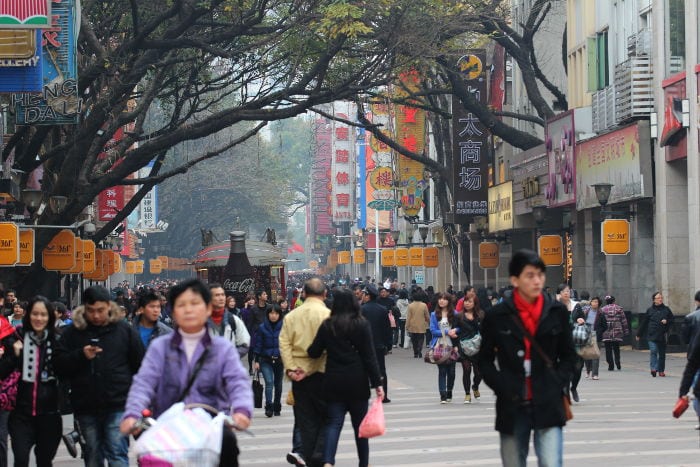
Guangzhou, the capital of Guangdong
Known in the west by the name of Canton, Guangzhou is the largest and most populous city in Guangdong as well as one of the biggest cities in China with its fifteen million inhabitants. The city is well connected with the rest of the country, and so I recommend that you start your trip from here.
Two or three days are sufficient to see Guangzhou; the city developed along the Pearl River, the area along the river is quite nice for taking a stroll in the evening, and here you can find restaurants of all sorts, nightclubs, and hotels for all budgets.
Beijing Road is the main street, a long pedestrian road full of restaurants, shopping malls, souvenir stores and street merchants selling bags, watches, etc. The area around Beijing Road is considered the city center; here is where you’ll find the city’s biggest attractions and can taste excellent dim sum, just lose yourself in one of the tiny roads!
I also recommend that you take a walk among the colonial villas in the eastern part of the city, easily reached by the YangJi metro stop (扬箕).
What to see in Guangzhou:
- Shamian Island (沙面岛)
- The Temple of the Chen family Ancestors (陈家祠)
- Sei Banani Temple(六榕寺)
- Cathedral of the Sacred Heart (石室教堂)
- Guangzhou Museum of Art(广州艺术博物馆)
- Yuexiu Park and Orchid Garden (越秀公园,兰圃)
Click here to read our tourist guide to Guangzhou.
Where to stay in Guangzhou
Finding a hotel or hostel in Guangzhou is really easy, there are accommodations of all types in every part of the city: here are the hotels that we recommend!
Getting around Guangzhou
Continuing your trip around Guangdong will be quite easy, long distance buses and trains will allow you to get to each area and tourist destination in the region. You just need to know the three main stations of the city:
- Guangzhou Railway Station (广州站): the majority of slow and night trains leave from the central station of Guangzhou, while outside the station you’ll find the stalls for long distance bus departures.
- Guangzhou South Station (广州南站): the majority of high speed trains leave from the southern station of Guangzhou, the modern station is about an hour away from the city center by metro.
- Guangzhou East Station (广州东站): if you want to get to Hong Kong from Guangzhou you need to go to the East Station; it isn’t very big but its very crowded due to the many passengers heading to Hong kong from Guangzhou. To buy a ticket go to the second floor of the station. My advice is to get your ticket in advance because even though there are lots of trains that leave for Hong Kong, there’s strong demand.
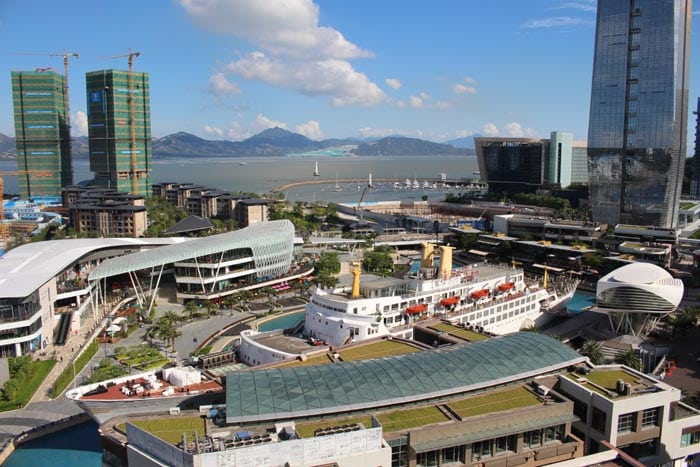
Shenzhen, the incredible megalopolis
Incredible is the adjective that best describes the city of Shenzhen, and that’s what you’ll think when you move through its spectacular skyscrapers that are the envy of the world’s largest megalopolises and realize that before the ’80’s the only thing here were a few fishing villages.
Shenzhen’s history begins in 1980, when then president Deng Xiaoping decided to institute the first special economic zone, thereby attracting entrepreneurs from nearby Hong Kong and the rest of the world, and factory after factory, skyscraper after skyscraper Shenzhen became a megalopolis of 14 million inhabitants, considered a miracle of contemporary urban planning.
What to see in Shenzhen
With only forty years of history don’t expect a traditional city nor monuments or ancient temples. However a visit to Shenzhen deserves at least one day for its spectacular museums, art galleries and walks along the sea, not to forget the spectacular nightlife with all sorts of clubs and cocktails.
Among the things you can see I would recommend:
- The Shenzhen Museum, where you can admire the city’s incredible transformation
- The OCT contemporary art terminal, an art gallery that has exhibited works from important Chinese artists
- Window of the World, a pleasant theme park.
Obviously the city offers many other things. If you’re staying in Shenzhen for awhile I recommend that you take a look at our article about the main tourist attractions of Shenzhen.
Where to stay in Shenzhen
From luxury hotels to hostels for transiting travelers, Shenzhen certainly doesn’t lack places to spend the night depending on your budget and requirements.
Click here to read our reviews of the best hotels in Shenzhen.
Getting around Shenzhen
The main station in Shenzhen is found in the southern part of the city, and is called the Luohu Station (罗湖). From here buses leave connecting Shenzhen with almost all other places in the province, and trains leave for Guangzhou East Station, taking an hour and a half for 45 Yuan.
The fast trains are found in the north of the city, the Shenzhen North Station (深圳北站). Many trains also depart from here connecting Shenzhen with different important cities; the fast train for the Guangzhou South Station takes forty minutes and costs 47 Yuan.
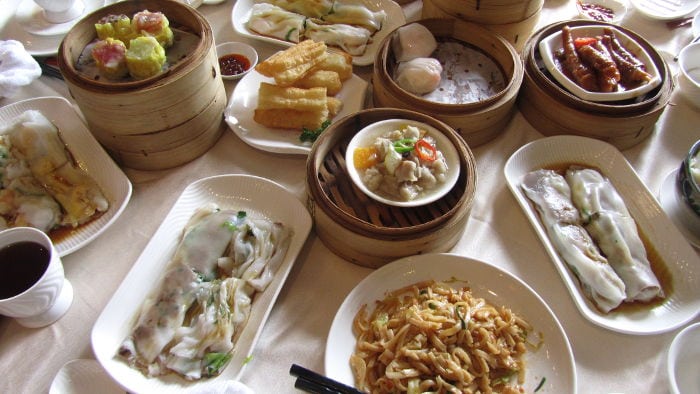
Dim Sum
Typical of the Guangdong region, “dim sum” is the Cantonese term for a snack, and corresponds with the Mandarin dian xin (点心); and being a snack you’ll see people throughout the region eating them at all hours.
Besides being a Cantonese delicacy, dim sum represents a rite, a moment to relax and times with friends and family, and it’s customary to eat them in many restaurants around the city and in villages and at home.
Upon entering a dim sum restaurant you’ll be served tea, each table has a kettle to continually warm water in a small sink to fill the teapot, then the numerous waiters that circle the restaurant with carts will give you the dim sum menu.
Once you have the menu in front of you you’ll see a white box next to each dish where you will need to fill out the number of servings you want to order. The dishes that make up dim sum are: won ton, small steamed sandwiches (baozi), rice pasta wraps, red bean or cream sweets, etc. The majority of dishes are steamed, and served while still inside the bamboo containers in which they are prepared (Longti 笼屉).
If dim sum is your choice for lunch then I also suggest that you order a dish of rice noodles.
Zhuhai, the city at the border of Macao
While you can cross the border on foot (or by ferry) from Shenzhen to Hong Kong, at Zhuhai you can cross to Macao on foot.
Click here to read our tourist guide to Zhuhai.
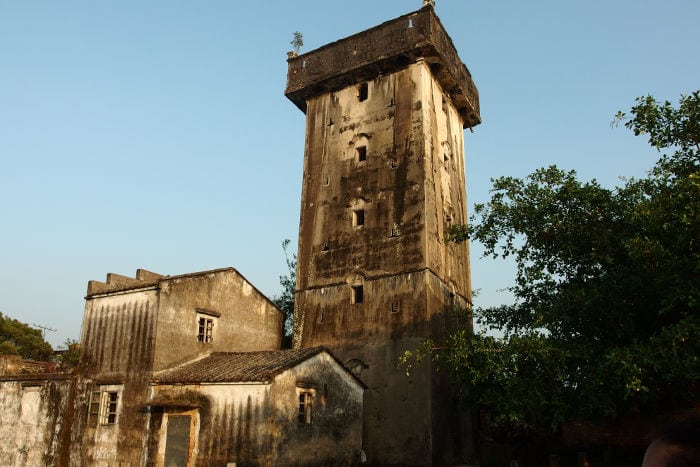
The Diaolou of Kaiping
The Diaolou of Kaiping (碉楼) are the watchtowers of a particular architectural style that unites Chinese and Western elements that are inscribed on the UNESCO World Heritage List.
Emigration and immigration phenomenons have for a long time characterized the province of Guangdong, and this has made it so that the arts and knowledge of Chinese and Western culture have blended in this region. An example of this cultural and artistic melting pot are the bizarre Diaolou of Kaiping, imposing towers that rise between small villages, fields of sorghum and small Chinese-style houses.
The first towers were built during the time of the Qing Dynsasty (1644-1911), and in the ’30’s there were more than three thousand towers in the area. Today there are about 1800 Diaolou of Kaiping spread among the various villages surrounding the area.
Traveling to Kaiping: advice and how to get there
If you’re planning to tour Guangdong you absolutely have to go to Kaiping, to see all the towers will take more than a week, but two or three days are enough to have a good idea of the diao lou and not miss the best ones.
Getting to Kaiping is very easy; the city doesn’t have a station, as it’s a small county in the city of Jiangmen (江门), so if you arrive by train you’ll come to nearby Jiangmen where you can take a bus to Kaiping, or you can comfortably take a taxi.
If instead you want to go directly to Kaiping then you have to take the bus you’ll find both from Guangzhou and Shenzhen (both outside the main train station). The bus takes about two hours and from both cities you’ll get to the Changsha bus station of Kaiping (长沙), right in the middle of the city.
I would recommend that you stay in Kaiping, you’ll find good hotels that are also very cheap. I personally recommend the Kaiping Hotel (开平酒店), in the middle of the city, near the bus stop for the Diaolou and an excellent place for Dim Sum! You can also stay in the more touristy villages around Kaiping, but the prices are slightly higher.
Visiting the Diaolou
Getting around between the Diaolou by bus is very convenient. There are lots of buses that run along the main roads and all you have to do is get off at the stop and delve into the villages to see the towers.
All the buses leave from Changsha Station, where besides buses you can rent scooters or transport of various types for the whole day (if you choose this option get ready to haggle, the prices they will offer are prohibited).
Another alternative is to go from one village to another asking for rides from scooter owners in the various villages, the price in this case varies between five and ten Yuan.
Here’s a list of villages that I visited and where I found Diaolou worth visiting:
- The village of Chikan (赤坎)
- The village of Jiangjiangli (降江里)
- The village and fields of Xiangang(蚬冈)
- The village of Pingxili (坪西里)
- The village of Nanxing (南兴), where there’s the famous leaning Diaolou
- The village of Yanbian (严边)
- The village of Zili (自立)
- The village of Majianglong (马降龙)
- The village of Sanmenli (三门里).
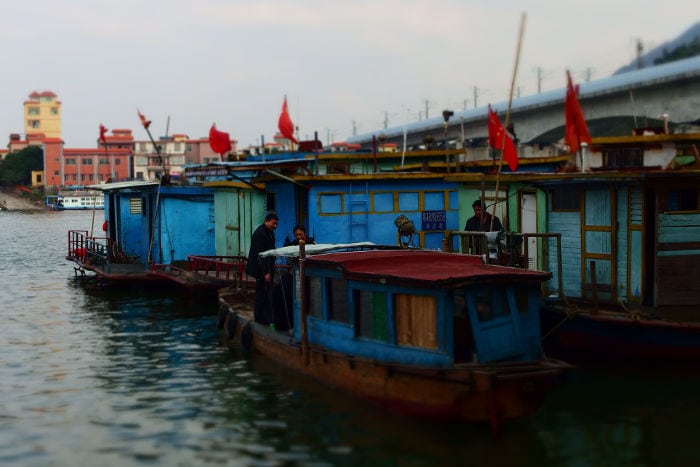
Rafting and cruising in the city of Qingyuan
The peaceful city of Qingyuan (清远) is located north of Guangzhou. The city offers little to nothing from an aesthetic point of view, being mainly a new industrial city, but at the same time offers a lot from a natural point of view, developing along the northern part of the Pearl River.
Getting to Qingyuan from Guangzhou is very easy; the fast train starts from the Gaugzhou Suoth Railway Station, takes a little less than half an hour and you’ll find a train every fifteen minutes; a ticket costs 40 Yuan.
My advice is to go to Qingyuan on a day trip from Guangzhou, where you’ll have the chance to go rafting and take a long tour along the northern part of the Pearl River, which takes its name from Hejiang (河江). If you decide to spend more time on the river then you should spend a night in Qingyuan.
Rafting
There are two places where you can go rafting near the city, which are: Huangteng Xia (黄腾峡) and Gulong Xia (古龙峡). Both aren’t far from the fast train station, just take a taxi for about 15 Yuan and you’ll get there comfortably. Rafting isn’t available all year long, just during the hot season: from mid-Spring to the beginning of Autumn.
A ticket for either place costs about 200 Yuan (depending on the season), and you can save about thirty Yuan booking in advance with an internet discount, but the site is only in Chinese.
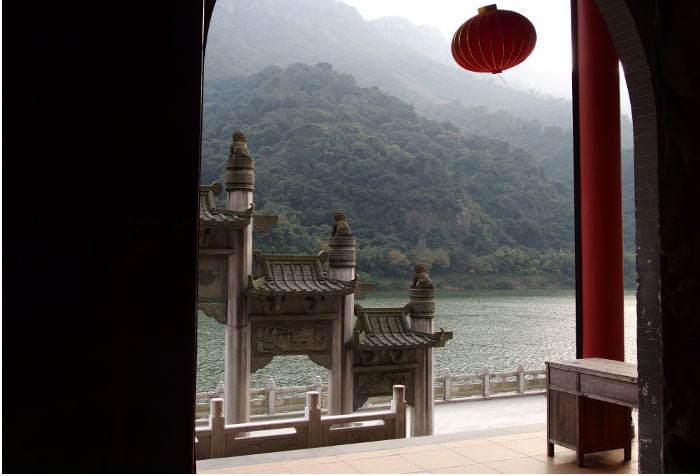
Cruise along the Beijiang
Despite using the term cruise, don’t expect a comfortable and luxurious trip, but rather a fun one with spectacular landscapes. On a travel blog I read about the boat trip from Qingyuan and a visit to the Feilai Temple (飞来寺)and the Feixia mountains and caves (飞霞). I stumbled across them and left feeling very satisfied.
Once you get to the high speed train station in Qingyuan take a taxi, a scooter or about a twenty minute walk to get to Wuyi Pier (五一码头).
At Wuyi Pier you’ll find every type of boat ready to offer you a ride along the river and a visit to the two places of interest in the area. The price of a boat varies a lot, from 200 to 500 Yuan, be ready to haggle. Leaving from the dock the first stop will be at the Feilai Temple, about an hour away. The boat will dock and you’ll have all the time you want to climb up to the temple built on the mountain.
This is a Buddhist temple, and was destroyed by a landslide in 1997, so much so that some parts of the temple are still under construction. It grew in height along the slopes of the mountain, and to reach the last section of the temple will take about a 40 minute walk.
Getting back on the boat for another hour of navigation, you’ll come to Mount Fenxia and its caves, which are very lovely and deserve at least a half hour’s visit.
Coming back to the boat you can continue your trip or return to the pier where you started – you decide if you want to spend the night in the city or keep traveling through the province.
Meizhou, the city of the Hakka
The Hakka (Kejia, 客家, in Chinese) are one of the 55 ethnic minorities in China. Like the majority of ethnic minorities, they are located in the southern part of the country. More precisely the hakka are divided among the south of Fujian and the north of Guangdong.
The minority enjoys a certain fame not just for its folklore customs, traditional dress and delicate and tasty cuisine, but also the strange shape of their traditional homes.
The homes of the Hakka take their name from weilongwu (围龙屋) and tulou (土楼), and are circular or horseshoe shaped ground plans that rise up from the rice paddies and watercourses of the region.
Meizhou is one of the hakka cities located in the northeast of Guangdong where you can find the circular homes, a beautiful museum on hakka culture (客家博物馆) and taste their wonderful cuisine.
I recommend that you get to Meizhou by bus from Guangzhou or Shenzhen, and start your visit to the city before moving on to the nearby towns that are full of nature and weilongwu homes.
I personally really enjoyed the village of Nankou (南口), lost in the rice paddies and sporting some of the most beautiful circular homes that I saw in the area.
Conclusion
I wrote this guide after two travel and work experiences in Guangdong, a region that I wouldn’t classify as the best place for history since it doesn’t have any ancient cities, or among the areas that boast the best natural landscapes.
But traveling in Guangdong helped me to better understand what China is in the twenty-first century, and which direction the country is moving in, divided between its ethnic minorities and its original and bizarre constructions of the last century on one hand, and the huge metropolises and old colones on the others – economically growing but still very human.
I’ll never forget the tea that was offered me outside the small stores of Guangzhou and Shenzhen, the dim sum eaten after long lines throughout the region, and a boat tour in Qingyuan together with some Chinese that celebrated the beginning of their vacations.
I hope you can have the same experiences I did. Happy travels!
Photo Credits: Photos by Gianluca Falso




We arrive Hong Kong by Cruise 9 July. Need a 4 to 6 day tour of Guangdong province (Guangzhou, Shenzhen and Shantou). We fly out of HKG morning of 16 July. Is it true we do not need a China Visa if we are on a tour for less than 5 days?
Hi there,
I don’t think it’s true. I mean, there are visa exemptions but not when arriving and departing from the same place. Also, there is a visa on arrival that can be done, but that’s only for Shenzhen